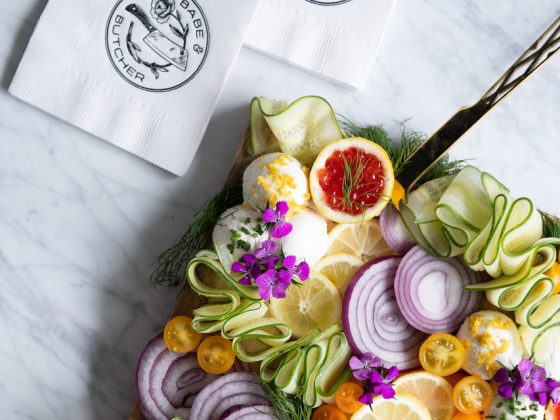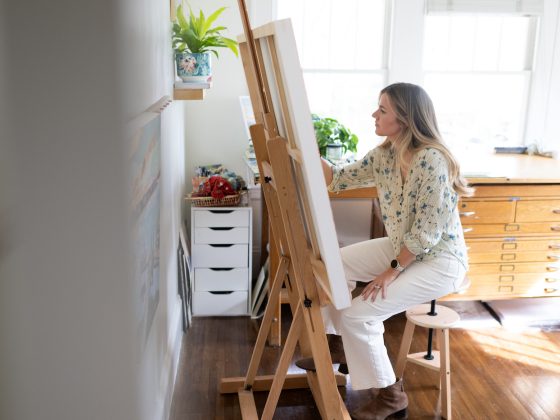Thomas Schmidt wears a lot of hats: He’s a working artist, the designer and co-founder of a project called Recycled China, and he is an Assistant Professor of Interdisciplinary 3D Studio and Digital Fabrication at the University of North Carolina at Charlotte.
Schmidt’s art is contemporary and eye-catching; he renders beautiful designs driven by his lasting fascination with exploring new technology and different digital fabrication methods. He explains that his interest in ceramics first start with a love of nature.
“I spent a lot of time hiking in the Rockies as a kid, and when I took my first ceramics class years later, it was the ability to explore some semblance of geologic events on my table top that really excited me,” he explains. “I was lucky to be inspired by the natural environment and landscape at a young age, and on some level that sense of discovery continues to drive me today.”

Schmidt attended Loyola University in Chicago, then trained at Alfred University in western New York State before accepting a job at The Alfred/CAFA Ceramic Design for Industry Program in Beijing. The experience of working in China, a place uniquely bound with “such profound ceramics traditions,” changed Schmidt’s path forever. But first, let’s start at the beginning.
How did you first get into sculpting and playing with 3D forms?
While my initial focus was primarily ceramics, I was fortunate to get some early exposure to printmaking and graphic arts which would become more prominent in my later work.

Tell us more about 3D scanning.
I take dozens of pictures of a subject from different angles and use software to stitch them together into a three-dimensional mesh. Once I have this mesh, it can be altered and manipulated and then brought back into a physical space through 3D printing or other fabrication methods. The whole shift from real space into a virtual space and back again is one that I think is worth exploring because it relates so closely to how we are increasingly experiencing the world around us as we operate and communicate on screens and then shift into personal contact with one another.
Do you have a favorite technique, or one that you have been using most recently?
I am constantly trying to keep things fresh in the studio, and I have found that learning new techniques and processes is a great way to do that. Right now, it is the use of computer-aided design and fabrication that has kept me pretty consumed. I love being able to explore and experiment in a digital space before bringing ideas into physical space. In ceramics, there is this element of excitement that one gets from working at lengths on a piece and then anticipating the final reveal when you open the kiln. In some ways, working with 3D printers or other digital fabrication tools has that same element of surprise: You can plan for weeks but the idea remains abstract until it is manifested in physical space.
Of course, it wouldn’t be as exciting if you didn’t get a complete failure now and again.
Who are the major inspirations for your art?
In recent years, I have been especially inspired by installation artists whose work draws attention to perception, with works exploring color, light and materiality, like Do Ho Suh, Olafur Eliasson and Tara Donovan. When it comes to more direct influences though, I had some pretty impactful teachers and mentors over the years, such as the ceramic sculptor Ruth Duckworth who I worked for as a studio assistant for a few years before she passed away.

You mention on your website this idea of taking samples of material moments and then reconstructing or distorting them leads to something akin to the “shift from experience to memory.” This reminds me of writing fiction, where many authors say that they use old experiences to create new truths, or “lie to tell the truth.”
I love this question, and it makes me want to get a reading list from you! The idea of lying to tell the truth is right on. In many ways, contemporary artists are operating as some combination of scientist, set-designer, and illusionist. We often conduct experiments, and in many cases the results are highly orchestrated to evoke a certain feeling or thought. What you often find is that that there is an incredibly messy, alchemic and often flawed process that results in the intentional and seemingly perfect outcome that makes it onto the gallery wall.
Tell us more about your continued work in China, like the Recycled China project you co-founded.
Some of my favorite memories in China were while visiting the city of Jingdezhen. This city has a history of producing remarkable pottery for nearly 2000 years, and the entire city still revolves around clay. The most exciting recent project has been to work with a new design gallery and educational venue in China called Design Society. This amazing place was developed in partnership with the Victoria and Albert Museum in London. One of the cool things about this project is that we collaborated across continents with Jeffrey and the Design Society in China, the designer of the bench Sam Jacobs Studio based in London, and myself based here in Charlotte.
Finally, you’re also a professor. When did you get involved with UNCC?
I have been working at the College of Art and Architecture at UNC Charlotte since the Fall of 2013. I love teaching here. Besides having an awesome, motivated and diverse student body, this is a research university, meaning that the school really encourages and supports faculty work. With backing from the school, I have had the opportunity to work collaboratively with my incredible visual art colleagues here in my department as well as faculty in architecture. This cross-pollination between fields is what makes this a very progressive school and one of the reasons why UNC Charlotte is the fastest growing university within the UNC system.
If you want to see more work, visit: www.thomasschmidt.org or www.recycledchina.com. You can also see his work on display at Hodges Taylor gallery with an exhibition opening in September 2018.












